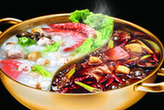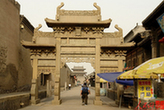The dance is vigorous and dignified. The dancers of the Nuo Dance all wear vivid, lifelike, wooden masks with different expressions, some of which are powerful and bold, some ferocious, some amiable and kind, some simple and naive, and some smiling and lovely. The dancing forms are rich and the movements diverse: some of which are agile and brave, some simple and powerful, and some nimble and bright. In these movements, there are a lot of elements of marital arts and opera postures, so it has specific flavors and characters.
As society evolved with a growing economy and more advanced technology, the Nuo dance began to lose popularity in most parts of China. Now it is only performed in remote townships and ethnic minority areas as a form of ancient sorcery. In some areas, the Nuo has been transformed into a folk dance simply for entertainment, replacing solemnity and mystery with artistic expression.
I Nanfeng Nuo Dance
Declarer: Nanfeng County, Jiangxi Province
The Nuo dance is a favorite folk dance in the villages of Nanfeng County. According to local history, the Nuo dance was performed in Nanfeng in the Han Dynasty (206 BC-220 AD) to dispel evil spirits. During the Ming and Qing period (1368-1911), the Nanfeng Nuo Dance absorbed various performing feats from operas, puppet shows, and martial arts and gradually developed into an entertainment. It currently preserves 82 dance forms, 180 sorts of masks, and 5 kinds of props including weapons, religious instruments, lighting, food offerings, and daily outfits.
II Wuyuan Nuo Dance
Declarer: Wuyuan County, Jiangxi Province
The Wuyuan Nuo Dance, also known as the Ghost Dance, is a 'living fossil' in terms of researching primitive Chinese dancing. It currently has more than 100 repertoires and over 200 masks. The Wuyuan Nuo Dance tells fairy tales and folk legends with its unique primitive, straightforward, exaggerated, and vivid performance.
III Le'an Nuo Dance
Declarer: Le'an County, Jiangxi Province
The Le'an Nuo Dance, also known as the Rolling Nuo Deity by the locals, has a history of about 1,000 years. It is a ritual to dispel evil, pray for good fortune, and safeguard the people and their home. The uniqueness that differentiates it from other Nuo dances lies in its mask, which, instead of a whole face, is made up of only a forehead and mouth. There are 18 sorts of mouths, such as snout or chicken mouths, which are rarely seen in other Nuo dances. Its accompanying music and primitive dance movements are also particular. The Rolling Nuo Deity is by far the only most primitive Nuo ritual and dance to survive.
Editor: Li Jing





Why not rent a boyfriend, or girlfriend to please parents during the Spring Festival?